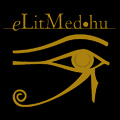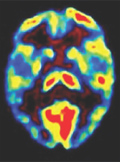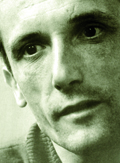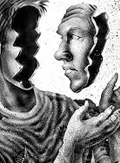The eLitMed.hu medical portal uses computer cookies for convenient operation. Detailed information can be found in the Cookie-policy.
Lege Artis Medicinae - 2012;22(08-09)
Content
[Systemic diseases in pseudoexfoliation syndrome]
[Pseudoexfoliation syndrome is a condition associated with the production and accumulation of a pathological protein (pseudoexfoliation material). Originally, the syndrome was recognised on the basis of its intraocular symptoms and had been considered to be an isolated eye disease for a long time. However, some 20 years ago it became clear that in pseudoexfoliation syndrome pseudoexfoliation material is present all over in the body. In the past decade, vascular dysfunction associated with this syndrome has been also recognised. Recent studies have shown that pseudoexfoliation syndrome is caused by genetic alterations affecting a lysil oxidaselike (LOXL) protein, LOXL1. LOXL1 has an important role in the synthesis of extracellular material. To our current knowledge, pseudoexfoliation syndrome is a systemic elastosis associated with oxidative stress. Its complications are in part ocular (development of nuclear cataract, zonular damage and development of pseudoexfoliative glaucoma) and in part systemic (dysfunction of capillaries, muscular and elastic arteries, impairment of baroreflex function, increase of arterial rigidity, development of aorta aneurism, recurrent venous occlusions and neurosensory hearing loss). Despite the recognition of the above complications, currently it is not possible to set guidelines of a potential cardiovascular screening for patients with pseudoexfoliation syndrome, since the frequency and significance of systemic complications vary across different populations.]
[Therapeutic potential and risks of ayahuasca]
[Ayahuasca, which originates from the Amazon Basin, is a psychoactive brew of two components. Its active agents are betacarboline and tryptamine derivatives. Near the spring of the Amazon River this brew is still a central component of many healing and tribal rituals. During the past few decades, the substance has become known among both laymen and scientistss and nowadays its use is spreading all over in Europe. In the present paper we give an overview of the scientific research and describe ayahuasca's main features, the main questions raised over its use, the risk factors and potential benefits. A growing number of scientific results seem to support the psychotherapeutic potential of ayahuasca, which has a strong serotonergic effect, whereas studies on its effect on the immune system also raise the possibility that certain ethno-medical observations can be scientifically proved.]
[Hypertension in the elderly - critical review of diagnostic-therapeutic guidelines and their background]
[In the majority of old and very old hypertensive patients, the reduction of abnormally high blood pressure has been proved to provide a strategic defense of target organs. In patients younger than 80 years, both initial and target blood pressure (BP) values are similar to those of younger age groups. In those older than 80 years, a a systolic blood pressure level >160 mmHg is the threshold of indication for antihypertensive treatment and the therapeutic target value is<150 mmHg. Both values are evidence- based (HYVET). The latest ACCF/AHA guidelines (USA 2011) advise to achieve a BP below 140 mmHg if the use of one or two antihypertensive agents result in sufficient BP reduction. However, this strategy is not yet supported by unequivocal evidence regarding complications in target organs. It is not recommended to aim for target levels lower than the above values (especially the value defined by the ESH guidelines) even in elderly hypertensive patients at high cardiovascular risk, as the results of several studies suggest a J-curve effect. In multimorbid elderly patients it is highly important to adapt antihypertensive treatment to individual needs, rather than to use schematic approaches. The number and progression of comorbid diseases can greatly influence, in certain cases attenuate the aimed BP reduction. A similar medical decision should be made if the target BP level could only be achieved by the combination of multiple antihypertensive medications, which can remarkably impair quality of life in elderly patients. Among non-comorbid elderly patients with hypertension, there seems to be no convincing difference in the efficiency of target organ protection between antihypertensive treatments that have different target sites but can achieve similar target levels. However, the majority of elderly hypertensive patients have comorbidities with variable rates of progression. In those at even low cardiometabolic risk the use of beta-receptor blockers (BRB) and especially a combination of BRB+diuretic (DIU) is not recommended. The adequate therapeutic tactic includes the use of only moderate drug-doses and their early combination. This approach has been convincingly proved mainly with early combinations of RAS inhibitors+CCB-s and RAS inhibitors+small doses of DIU-s. It is very important to monitor the treated patients, as the BP and circulatory response to the same antihypertensive treatment can markedly change in elderly patients when either the enviromental conditions change or a new pathologic process develops and/or is treated. Strict control is also necessary because it occurs quite often that the earlier optimal compliance of elderly patients in taking antihypertensive medicines rapidly deteriorates. The efficiency of statins and acetylsalicylic acid decreases over 80 years of age, but this does not indicate that the previously efficient approach should be suspended.]
[Dabigatran: a new oral anticoagulant agent for the prevention of stroke and systemic embolism in nonvalvular atrial fibrillation]
[In this article, we summarise the available information on dabigatran, focusing on clinical practice, in particular on the prevention of stroke and systemic embolism, the critical aspects of anticoagulant treatment with dabigatran, potential drug-drug interactions and adverse reactions in nonvalvular atrial fibrillation. The most important molecular characteristics of dabigatran are also described. We highlight the implications of safety issues that have emerged during everyday clinical practice.]
[Rosuvastatin for the treatment of diabetic dyslipidaemia]
[Cardiovascular disease is a leading cause of death. The incidence of type 2 diabetes is increasing worldwide as well as in Hungary. Diabetes mellitus is a high-risk state, and if associated with coronary disease, it is considered a very high-risk condition. According to the 5th Cardiovascular Consensus Conference and ESC/EAS, the target level of LDL-cholesterol should be <2.5 mmol/l in high-risk condition and <1.8 mmol/l in very high-risk condition. In diabetes, one of the main goals is to achieve target LDL-cholesterol levels, which require lifestyle changes as a first step, followed by statin treatment, in combination with with ezetimibe if necessary. Statins are also known to have diabetogenic effects, which are dose-dependent. The advantage of the preventive cardiovascular effects observed in nondiabetic patients substantially outweighs the risk of potentially developing diabetes mellitus, therefore, this risk should not hinder the use of statins. Statin treatment can substantially reduce cardiovascular events in patients with diabetes mellitus. The greatest reduction in LDL-cholesterol level can be achieved by the most efficient statin, rosuvastatin.]
[Stress load and health risk behaviour among medical, dental and pharmacy school students]
[INTRODUCTION - This study aims to analyse interrelations of stress load, mental state and work related symptoms with health risk behaviour of medical, dental and pharmacy school students. SAMPLE AND METHODS - 473 fourthyear students participated, 73.4% of medical, 10.1% of dental and 16.5% of pharmacy school. Measuring stress, we used the validated version of Anderson's questionnaire for mental, physical and work related divisions. Those with high level of stress on the score system entered the risk groups in the relevant divisions. Among health risks, tobacco smoking, alcohol consume, illegal drugs and psychoactive pharmaceuticals were measured. RESULTS - 15.2% of students perceived mental and 7.8% physical complaints. Work related symptoms were in 26.0% indicated. The overall prevalence of health risks were found to be 12.1% for smoking, 36.2% for drinking, 30.9% for drug use and 9.1% for taking pharmaceuticals. There was a significant (p<0.001) association between taking pharmaceuticals and all the three risk divisions. CONCLUSIONS - The prevalence of smoking is low in all student groups, but three out of ten students are regularly consuming alcohol and some kind of illegal drugs, yet there is no significant association between these health risks and the stress phenomena. Using pharmaceuticals is relatively less frequent, but it must be concerned that these drugs are taken primarily to manage stress related problems.]
1.
Clinical Neuroscience
Is there any difference in mortality rates of atrial fibrillation detected before or after ischemic stroke?2.
Clinical Neuroscience
Factors influencing the level of stigma in Parkinson’s disease in western Turkey3.
Clinical Neuroscience
Neuropathic pain and mood disorders in earthquake survivors with peripheral nerve injuries4.
Journal of Nursing Theory and Practice
[Correlations of Sarcopenia, Frailty, Falls and Social Isolation – A Literature Review in the Light of Swedish Statistics]5.
Clinical Neuroscience
[Comparison of pain intensity measurements among patients with low-back pain]1.
Clinical Neuroscience Proceedings
[A Magyar Stroke Társaság XVIII. Kongresszusa és a Magyar Neuroszonológiai Társaság XV. Konferenciája. Absztraktfüzet]2.
3.
Journal of Nursing Theory and Practice
[A selection of the entries submitted to the literary contest "Honorable mission: the joys and challenges of our profession" ]4.
Journal of Nursing Theory and Practice
[End of Life and Palliative Care of Newborns in the Nursing Context]5.
Journal of Nursing Theory and Practice
[Aspects of Occupational Health Nursing for Incurable Patients ]













